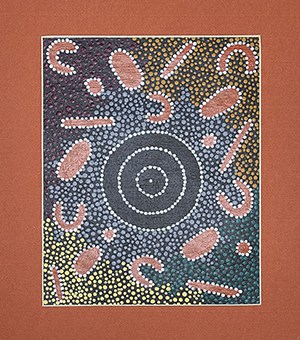Embrace the Splendor of Aboriginal Dot Art with Your Little Ones!
Welcome, creative families! Are you looking for a fun and educational way to introduce your children to the richness of Aboriginal culture through art? You’ve landed in the perfect place! Aboriginal dot art is not just a painting; it’s a journey through stories, traditions, and history. In this guide, we’ll explore the beauty and significance of Aboriginal dot art painting and share tips on how you can create these magnificent works with your kids, right from the cozy corners of your home.
The Origins and Importance of Aboriginal Dot Art
Before we dive into the paints and brushes, let’s take a moment to appreciate the deep cultural significance of Aboriginal dot art. Originating from Australia, this art form is a sacred tradition of Indigenous Australians, often used as a means of storytelling and preserving history. Each dot, color, and symbol represents elements from nature, ancestral tales, and spiritual beliefs, making every piece a narrative canvas.
Materials You’ll Need to Get Started
Ready to get your hands dotted with vibrant colors alongside your kids? Here’s what you’ll need:
- Canvas or Paper: A sturdy base that can support layers of paint.
- Acrylic Paints: A selection of colors inspired by the rich hues of the Australian landscape.
- Dotting Tools: You can use special dotting tools, or be resourceful with the ends of paintbrushes, cotton swabs, or even the tip of a pencil.
- Palette or Plate: To mix and hold your paints.
- Protective Covering: Keep your work area clean with some old newspapers or a drop cloth.
- Sealer (Optional): To protect the finished artwork.
Step-by-Step: Creating Your First Dot Art Painting With Your Child
Now, let’s get to the exciting part – making art! Follow these steps to start your Aboriginal dot art adventure:
Step 1: Learn and Share about Aboriginal Cultures
Before starting with the colors, take some time to learn about Aboriginal cultures with your child. Read books, watch documentaries, or visit online resources to help set the stage for an educational and respectful art-making experience.
Step 2: Preparing Your Painting Space
Lay out your protective covering and gather all materials. Make sure the space is comfortable and has good lighting – creativity thrives when you’re comfy!
Step 3: Practice Dotting Techniques
On a piece of scrap paper, practice making dots of different sizes using your tools. Get a feel for how much paint you need, and how to create consistent patterns.
Step 4: Begin with a Background
Start by painting a solid background color or a simple landscape on your canvas. This will set the scene for your dot art.
Step 5: Sketch Your Design (Optional)
Lightly sketch out a design on the canvas with a pencil, if you’d like to have a guide. Remember, traditional Aboriginal art often tells a story or represents elements from the natural world.
Step 6: Let the Dotting Begin!
Now, start dotting! Encourage your child to dot along the lines or fill spaces with different colors. There’s no right or wrong – allow their imagination to guide them.
Step 7: Add Layers and Details
Continue building up the painting by adding layers of dots. As you get more confident, experiment with different sizes and colors to create depth and texture.
Dot by dot, you and your little artist will soon bring to life a beautiful representation of an ancient art form. With each dab, you’re not just making art; you’re building an understanding and respect for one of the world’s oldest continuous cultures. Stay tuned, as our next section will delve into the nuances of deciphering symbolism in Aboriginal art and how to infuse greater meaning into your own creations. Remember, each painting you create with your child is a unique tale, told from the heart through a thousand dots.

5 Things Parents Should Know in Preparing for Aboriginal Dot Art Painting
Embarking on this artistic adventure with your children can be a delightful experience. Keeping a few things in mind before you start can help make the process smoother and more meaningful:
1. Understand the Cultural Significance
Aboriginal dot art is more than just an art activity; it’s a cultural expression that deserves respect. Discuss with your children the importance of the art form, its origins, and what it represents. It’s essential that while creating art, we are also acknowledging and honoring the culture from which it comes.
2. Choosing the Right Materials
Opt for high-quality, non-toxic paints and sturdy canvases or paper to ensure the best outcome. Remember, you don’t need to buy expensive materials; sometimes, the best tools are already in your home. What’s important is the time spent together, exploring and learning through art.
3. Creating the Right Environment
A relaxed atmosphere is key to a joyful art session. Choose a well-ventilated space with ample lighting, and don’t forget to protect surfaces against spills! Background music, perhaps featuring traditional Aboriginal instruments, can set the tone and enrich the experience.
4. Emphasize the Process Over Perfection
When introducing your children to Aboriginal dot art, emphasize the enjoyment and learning over creating a ‘perfect’ artwork. The goal is to express creatively and connect with cultural teachings, not to judge the artistic outcome.
5. Be Open to Learning Together
It’s okay not to have all the answers about Aboriginal culture and art. Use this opportunity to learn alongside your child. Encourage questions and seek out answers together. It is a beautiful way to show that learning is a lifelong process.
Taking on Aboriginal dot art painting can become one of the most fulfilling activities you share with your children, paving the way for other cultural discovery and artistic endeavors.
Understanding Aboriginal Dot Art Symbolism with Kids
Aboriginal dot art is rich in symbols and hidden meanings. Each painting tells a story, and deciphering this visual language can be fascinating. Spend time with your children exploring what different symbols mean, such as circles often representing campsites or waterholes, and animal tracks indicating the presence of wildlife. Pay attention to the use of colors as well; ochre reds, desert yellows, and sky blues can all have specific connotations relating to the land and sky.
By engaging your children in interpreting these symbols, you’re not only nurturing their analytical skills but also instilling a deep appreciation for storytelling and the power of visual expression.
As you progress on your journey of creating Aboriginal dot art with your children, cherish each moment of this cultural exploration. By approaching this experience with an open heart and mind, you provide a canvas for your children not only to paint upon but also to imprint their sense of wonder, curiosity, and respect for the world’s diverse heritage.
For more great fun click here. For more information see here
Disclaimer
The articles available via our website provide general information only and we strongly urge readers to exercise caution and conduct their own thorough research and fact-checking. The information presented should not be taken as absolute truth, and, to the maximum extent permitted by law, we will not be held liable for any inaccuracies or errors in the content. It is essential for individuals to independently verify and validate the information before making any decisions or taking any actions based on the articles.




